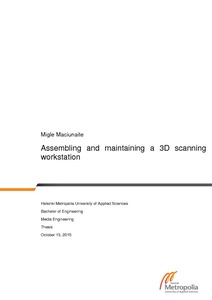Assembling and maintaining a 3D scanning workstation
Maciunaite, Migle (2015)
Maciunaite, Migle
Metropolia Ammattikorkeakoulu
2015
All rights reserved
Julkaisun pysyvä osoite on
https://urn.fi/URN:NBN:fi:amk-2015110515993
https://urn.fi/URN:NBN:fi:amk-2015110515993
Tiivistelmä
The purpose of this thesis is to describe how three different 3D scanning methods were implemented for building a small workstation that would be easy to use to produce 3D models that can be applied in further computer aided design or 3D printing.
3D scanning technology, which uses sensors that collect light, is still developing. Most of the literature about it is from blogs and software websites, giving short introduction to it and tutorials about home-use 3D scanners. Thus, further research needed to be done when choosing which programmes and sensors to work with.
The practical part of this thesis was to do 3D scanning tests of objects that would vary in size, colour, and material and that also have different lighting settings. It was important to find out what the smallest and biggest size of an object was which could be scanned. As well as that, one of the key focuses was to learn how well the scanned objects could interact together with other computer-aided design programmes which have been used in Helsinki Metropolia University of Applied Sciences.
The programmes that were used in this project gave ordinary results. One of the programmes that was originally chosen for this project did not work with the sensor. Therefore other programmes had to be used. Some of the objects could not be scanned, because they were too dark, too bright, and too transparent or were scanned in poor lighting. 3D scanning is not as time consuming as the conventional technology, where the objects would be modelled from scratch, but it had fewer details and sometimes was lacking information, such as texture, once it was imported to other software. This could have happened due to lack of skills and time with computer-aided design programmes.
In conclusion, the low cost 3D scanners are promising and could bring interesting applications, but do not yet deliver an excellent outcome. However, they can be used as research and introduction technology for students that show interest in this area.
3D scanning technology, which uses sensors that collect light, is still developing. Most of the literature about it is from blogs and software websites, giving short introduction to it and tutorials about home-use 3D scanners. Thus, further research needed to be done when choosing which programmes and sensors to work with.
The practical part of this thesis was to do 3D scanning tests of objects that would vary in size, colour, and material and that also have different lighting settings. It was important to find out what the smallest and biggest size of an object was which could be scanned. As well as that, one of the key focuses was to learn how well the scanned objects could interact together with other computer-aided design programmes which have been used in Helsinki Metropolia University of Applied Sciences.
The programmes that were used in this project gave ordinary results. One of the programmes that was originally chosen for this project did not work with the sensor. Therefore other programmes had to be used. Some of the objects could not be scanned, because they were too dark, too bright, and too transparent or were scanned in poor lighting. 3D scanning is not as time consuming as the conventional technology, where the objects would be modelled from scratch, but it had fewer details and sometimes was lacking information, such as texture, once it was imported to other software. This could have happened due to lack of skills and time with computer-aided design programmes.
In conclusion, the low cost 3D scanners are promising and could bring interesting applications, but do not yet deliver an excellent outcome. However, they can be used as research and introduction technology for students that show interest in this area.
